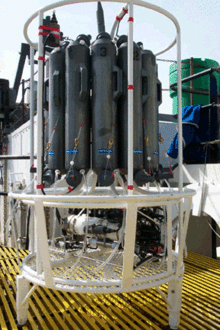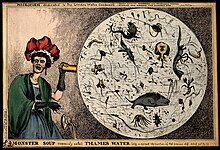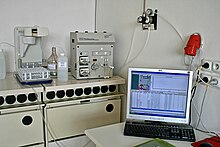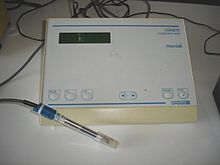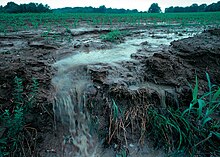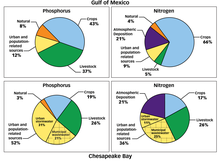A rosette sampler is used for collecting water samples in deep water, such as the Great Lakes or oceans, for water quality testing.
Water quality refers to the chemical, physical, biological, and radiological characteristics of water. It is a measure of the condition of water relative to the requirements of one or more biotic species and or to any human need or purpose. It is most frequently used by reference to a set of standards against which compliance, generally achieved through treatment of the water, can be assessed. The most common standards used to assess water quality relate to health of ecosystems, safety of human contact, and drinking water.
Standards
In the setting of standards, agencies make political and technical/scientific decisions about how the water will be used. In the case of natural water bodies, they also make some reasonable estimate of pristine conditions. Natural water bodies will vary in response to environmental conditions. Environmental scientists work to understand how these systems function, which in turn helps to identify the sources and fates of contaminants. Environmental lawyers and policymakers work to define legislation with the intention that water is maintained at an appropriate quality for its identified use.The vast majority of surface water on the Earth is neither potable nor toxic. This remains true when seawater in the oceans (which is too salty to drink) is not counted. Another general perception of water quality is that of a simple property that tells whether water is polluted or not. In fact, water quality is a complex subject, in part because water is a complex medium intrinsically tied to the ecology of the Earth. Industrial and commercial activities (e.g. manufacturing, mining, construction, transport) are a major cause of water pollution as are runoff from agricultural areas, urban runoff and discharge of treated and untreated sewage.
Categories
The parameters for water quality are determined by the intended use. Work in the area of water quality tends to be focused on water that is treated for human consumption, industrial use, or in the environment.Human consumption
Contaminants that may be in untreated water include microorganisms such as viruses, protozoa and bacteria; inorganic contaminants such as salts and metals; organic chemical contaminants from industrial processes and petroleum use; pesticides and herbicides; and radioactive contaminants. Water quality depends on the local geology and ecosystem, as well as human uses such as sewage dispersion, industrial pollution, use of water bodies as a heat sink, and overuse (which may lower the level of the water).The United States Environmental Protection Agency (EPA) limits the amounts of certain contaminants in tap water provided by US public water systems. The Safe Drinking Water Act authorizes EPA to issue two types of standards:
- primary standards regulate substances that potentially affect human health;
- secondary standards prescribe aesthetic qualities, those that affect taste, odor, or appearance.
In urbanized areas around the world, water purification technology is used in municipal water systems to remove contaminants from the source water (surface water or groundwater) before it is distributed to homes, businesses, schools and other recipients. Water drawn directly from a stream, lake, or aquifer and that has no treatment will be of uncertain quality.
Industrial and domestic use
Dissolved minerals may affect suitability of water for a range of industrial and domestic purposes. The most familiar of these is probably the presence of ions of calcium (Ca2+) and magnesium (Mg2+) which interfere with the cleaning action of soap, and can form hard sulfate and soft carbonate deposits in water heaters or boilers. Hard water may be softened to remove these ions. The softening process often substitutes sodium cations. Hard water may be preferable to soft water for human consumption, since health problems have been associated with excess sodium and with calcium and magnesium deficiencies. Softening decreases nutrition and may increase cleaning effectiveness. Various industries' wastes and effluents can also pollute the water quality in receiving bodies of water.Environmental water quality
Urban runoff discharging to coastal waters
Environmental water quality, also called ambient water quality, relates to water bodies such as lakes, rivers, and oceans. Water quality standards for surface waters vary significantly due to different environmental conditions, ecosystems, and intended human uses. Toxic substances and high populations of certain microorganisms can present a health hazard for non-drinking purposes such as irrigation, swimming, fishing, rafting, boating, and industrial uses. These conditions may also affect wildlife, which use the water for drinking or as a habitat. Modern water quality laws generally specify protection of fisheries and recreational use and require, as a minimum, retention of current quality standards.
Satirical cartoon by William Heath, showing a woman observing monsters in a drop of London water (at the time of the Commission on the London Water Supply report, 1828)
There is some desire among the public to return water bodies to pristine, or pre-industrial conditions. Most current environmental laws focus on the designation of particular uses of a water body. In some countries these designations allow for some water contamination as long as the particular type of contamination is not harmful to the designated uses. Given the landscape changes (e.g., land development, urbanization, clearcutting in forested areas) in the watersheds of many freshwater bodies, returning to pristine conditions would be a significant challenge. In these cases, environmental scientists focus on achieving goals for maintaining healthy ecosystems and may concentrate on the protection of populations of endangered species and protecting human health.
Sampling and measurement
The complexity of water quality as a subject is reflected in the many types of measurements of water quality indicators. The most accurate measurements of water quality are made on-site, because water exists in equilibrium with its surroundings. Measurements commonly made on-site and in direct contact with the water source in question include temperature, pH, dissolved oxygen, conductivity, oxygen reduction potential (ORP), turbidity, and Secchi disk depth.Sample collection
An automated sampling station installed along the East Branch Milwaukee River, New Fane, Wisconsin.
The cover of the 24-bottle autosampler (center) is partially raised,
showing the sample bottles inside. The autosampler was programmed to
collect samples at time intervals, or proportionate to flow over a
specified period. The data logger (white cabinet) recorded temperature,
specific conductance, and dissolved oxygen levels.
More complex measurements are often made in a laboratory requiring a water sample to be collected, preserved, transported, and analyzed at another location. The process of water sampling introduces two significant problems:
- The first problem is the extent to which the sample may be representative of the water source of interest. Many water sources vary with time and with location. The measurement of interest may vary seasonally or from day to night or in response to some activity of man or natural populations of aquatic plants and animals. The measurement of interest may vary with distances from the water boundary with overlying atmosphere and underlying or confining soil. The sampler must determine if a single time and location meets the needs of the investigation, or if the water use of interest can be satisfactorily assessed by averaged values with time and location, or if critical maxima and minima require individual measurements over a range of times, locations or events. The sample collection procedure must assure correct weighting of individual sampling times and locations where averaging is appropriate. Where critical maximum or minimum values exist, statistical methods must be applied to observed variation to determine an adequate number of samples to assess probability of exceeding those critical values.
- The second problem occurs as the sample is removed from the water source and begins to establish chemical equilibrium with its new surroundings – the sample container. Sample containers must be made of materials with minimal reactivity with substances to be measured; and pre-cleaning of sample containers is important. The water sample may dissolve part of the sample container and any residue on that container, or chemicals dissolved in the water sample may sorb onto the sample container and remain there when the water is poured out for analysis. Similar physical and chemical interactions may take place with any pumps, piping, or intermediate devices used to transfer the water sample into the sample container. Water collected from depths below the surface will normally be held at the reduced pressure of the atmosphere; so gas dissolved in the water may escape into unfilled space at the top of the container. Atmospheric gas present in that air space may also dissolve into the water sample. Other chemical reaction equilibria may change if the water sample changes temperature. Finely divided solid particles formerly suspended by water turbulence may settle to the bottom of the sample container, or a solid phase may form from biological growth or chemical precipitation. Microorganisms within the water sample may biochemically alter concentrations of oxygen, carbon dioxide, and organic compounds. Changing carbon dioxide concentrations may alter pH and change solubility of chemicals of interest. These problems are of special concern during measurement of chemicals assumed to be significant at very low concentrations.
Filtering a manually collected water sample (grab sample) for analysis
Sample preservation may partially resolve the second problem. A common procedure is keeping samples cold to slow the rate of chemical reactions and phase change, and analyzing the sample as soon as possible; but this merely minimizes the changes rather than preventing them. A useful procedure for determining influence of sample containers during delay between sample collection and analysis involves preparation for two artificial samples in advance of the sampling event. One sample container is filled with water known from previous analysis to contain no detectable amount of the chemical of interest. This sample, called a "blank", is opened for exposure to the atmosphere when the sample of interest is collected, then resealed and transported to the laboratory with the sample for analysis to determine if sample holding procedures introduced any measurable amount of the chemical of interest. The second artificial sample is collected with the sample of interest, but then "spiked" with a measured additional amount of the chemical of interest at the time of collection. The blank and spiked samples are carried with the sample of interest and analyzed by the same methods at the same times to determine any changes indicating gains or losses during the elapsed time between collection and analysis.
Testing in response to natural disasters and other emergencies
Inevitably after events such as earthquakes and tsunamis, there is an immediate response by the aid agencies as relief operations get underway to try and restore basic infrastructure and provide the basic fundamental items that are necessary for survival and subsequent recovery. Access to clean drinking water and adequate sanitation is a priority at times like this. The threat of disease increases hugely due to the large numbers of people living close together, often in squalid conditions, and without proper sanitation.After a natural disaster, as far as water quality testing is concerned there are widespread views on the best course of action to take and a variety of methods can be employed. The key basic water quality parameters that need to be addressed in an emergency are bacteriological indicators of fecal contamination, free chlorine residual, pH, turbidity and possibly conductivity/total dissolved solids. There are a number of portable water test kits on the market widely used by aid and relief agencies for carrying out such testing.
After major natural disasters, a considerable length of time might pass before water quality returns to pre-disaster levels. For example, following the 2004 Indian Ocean tsunami the Colombo-based International Water Management Institute (IWMI) monitored the effects of saltwater and concluded that the wells recovered to pre-tsunami drinking water quality one and a half years after the event. IWMI developed protocols for cleaning wells contaminated by saltwater; these were subsequently officially endorsed by the World Health Organization as part of its series of Emergency Guidelines.
Chemical analysis
The simplest methods of chemical analysis are those measuring chemical elements without respect to their form. Elemental analysis for oxygen, as an example, would indicate a concentration of 890 g/L (grams per litre) of water sample because oxygen (O) has 89% mass of the water molecule (H2O). The method selected to measure dissolved oxygen should differentiate between diatomic oxygen and oxygen combined with other elements. The comparative simplicity of elemental analysis has produced a large amount of sample data and water quality criteria for elements sometimes identified as heavy metals. Water analysis for heavy metals must consider soil particles suspended in the water sample. These suspended soil particles may contain measurable amounts of metal. Although the particles are not dissolved in the water, they may be consumed by people drinking the water. Adding acid to a water sample to prevent loss of dissolved metals onto the sample container may dissolve more metals from suspended soil particles. Filtration of soil particles from the water sample before acid addition, however, may cause loss of dissolved metals onto the filter. The complexities of differentiating similar organic molecules are even more challenging.
Atomic fluorescence spectroscopy is used to measure mercury and other heavy metals
Making these complex measurements can be expensive. Because direct measurements of water quality can be expensive, ongoing monitoring programs are typically conducted by government agencies. However, there are local volunteer programs and resources available for some general assessment. Tools available to the general public include on-site test kits, commonly used for home fish tanks, and biological assessment procedures.
Real-time monitoring
Although water quality is usually sampled and analyzed at laboratories, nowadays, citizens demand real-time information about the water they are drinking. During the last years, several companies are deploying worldwide real-time remote monitoring systems for measuring water pH, turbidity or dissolved oxygen levels.Drinking water indicators
An electrical conductivity meter is used to measure total dissolved solids
The following is a list of indicators often measured by situational category:
- Alkalinity
- Color of water
- pH
- Taste and odor (geosmin, 2-Methylisoborneol (MIB), etc.)
- Dissolved metals and salts (sodium, chloride, potassium, calcium, manganese, magnesium)
- Microorganisms such as fecal coliform bacteria (Escherichia coli), Cryptosporidium, and Giardia lamblia; see Bacteriological water analysis
- Dissolved metals and metalloids (lead, mercury, arsenic, etc.)
- Dissolved organics: colored dissolved organic matter (CDOM), dissolved organic carbon (DOC)
- Radon
- Heavy metals
- Pharmaceuticals
- Hormone analogs
Environmental indicators
Physical indicators
|
|
Chemical indicators
|
|
Biological indicators
|
|
|
Individuals interested in monitoring water quality who cannot afford or manage lab scale analysis can also use biological indicators to get a general reading of water quality. One example is the IOWATER volunteer water monitoring program of Iowa, which includes a benthic macroinvertebrate indicator key.
Bivalve molluscs are largely used as bioindicators to monitor the health of aquatic environments in both fresh water and the marine environments. Their population status or structure, physiology, behaviour or the level of contamination with elements or compounds can indicate the state of contamination status of the ecosystem. They are particularly useful since they are sessile so that they are representative of the environment where they are sampled or placed. A typical project is the U.S. Mussel Watch Programme, but today they are used worldwide.
The Southern African Scoring System (SASS) method is a biological water quality monitoring system based on the presence of benthic macroinvertebrates. The SASS aquatic biomonitoring tool has been refined over the past 30 years and is now on the fifth version (SASS5) which has been specifically modified in accordance with international standards, namely the ISO/IEC 17025 protocol. The SASS5 method is used by the South African Department of Water Affairs as a standard method for River Health Assessment, which feeds the national River Health Programme and the national Rivers Database.
Standards and reports
International
- The World Health Organisation (WHO) has published guidelines for drinking-water quality (GDWQ) in 2011.
- The International Organization for Standardization (ISO) published regulation of water quality in the section of ICS 13.060, ranging from water sampling, drinking water, industrial class water, sewage, and examination of water for chemical, physical or biological properties. ICS 91.140.60 covers the standards of water supply systems.
National specifications for ambient water and drinking water
European Union
The water policy of the European Union is primarily codified in three directives:- Directive on Urban Waste Water Treatment (91/271/EEC) of 21 May 1991 concerning discharges of municipal and some industrial wastewaters;
- The Drinking Water Directive (98/83/EC) of 3 November 1998 concerning potable water quality;
- Water Framework Directive (2000/60/EC) of 23 October 2000 concerning water resources management.
India
- Indian Council of Medical Research (ICMR) Standards for Drinking Water.
South Africa
Water quality guidelines for South Africa are grouped according to potential user types (e.g. domestic, industrial) in the 1996 Water Quality Guidelines. Drinking water quality is subject to the South African National Standard (SANS) 241 Drinking Water Specification.United Kingdom
In England and Wales acceptable levels for drinking water supply are listed in the "Water Supply (Water Quality) Regulations 2000."United States
In the United States, Water Quality Standards are defined by state agencies for various water bodies, guided by the desired uses for the water body (e.g., fish habitat, drinking water supply, recreational use). The Clean Water Act (CWA) requires each governing jurisdiction (states, territories, and covered tribal entities) to submit a set of biennial reports on the quality of water in their area. These reports are known as the 303(d) and 305(b) reports, named for their respective CWA provisions, and are submitted to, and approved by, EPA. These reports are completed by the governing jurisdiction, typically a state environmental agency. EPA recommends that each state submit a single "Integrated Report" comprising its list of impaired waters and the status of all water bodies in the state. The National Water Quality Inventory Report to Congress is a general report on water quality, providing overall information about the number of miles of streams and rivers and their aggregate condition. The CWA requires states to adopt standards for each of the possible designated uses that they assign to their waters. Should evidence suggest or document that a stream, river or lake has failed to meet the water quality criteria for one or more of its designated uses, it is placed on a list of impaired waters. Once a state has placed a water body on this list, it must develop a management plan establishing Total Maximum Daily Loads (TMDLs) for the pollutant(s) impairing the use of the water. These TMDLs establish the reductions needed to fully support the designated uses.Drinking water standards, which are applicable to public water systems, are issued by EPA under the Safe Drinking Water Act.
